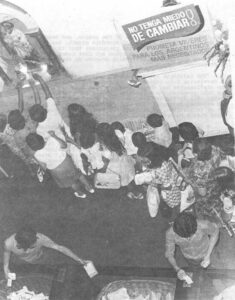Penny Lernoux
- 1976

Fellowship Title:
- The Revolution in the Roman Catholic Church in Latin America
Fellowship Year:
- 1976
New Hope in Latin America: The Church of the Catacombs
MANAGUA, Nicaragua — Among the martyrs in the early Latin American Catholic Church is a little known Nicaraguan bishop, Antonio Valdivieso, who was killed in 1550 by the son of the colonial governor in the city of Leon for refusing to sanction Indian slave labor. Like many such men in Central and South America, Valdivieso does not appear in Latin American history books because he belongs to the forgotten pages of colonial history, his story obscured by the popular saga of cross and sword. The historical image of the Catholic Church in Latin America is the Church of the conquistadores, of the Inquisition, of religious fanatics firing the temples of the great pre-Columbian civilizations. Yet there was another Church as well, the protector of the Indians, the refuge of the poor. It is this Church that has risen again in Latin America. After centuries of luxury and corruption, and of good works, too, the Catholic Church is harkening back to the lessons of men like Valdivieso, who proved that personal sacrifice is the most effective
Brazil: The Church of Tomorrow
“We are the people of the nation.We are the people of God.We want a place on earth.We already have one in heaven.”(interpreted from the Portuguese) A “cry from the soul” of Bishop Pedro Casaldaliga, these lines, written in 1971 in the depths of the Amazon Jungle, were scratched on the back of a wild banana leaf with the point of a pocket knife. They are today a national hymn of Brazil and the rallying cry of 10 million landless peasant families. A short wisp of a man with the courage of a martyr, Dom Pedro is typical of the fighting bishops of Brazil. Leaders of the world’s largest Catholic Church and in many ways its most progressive, Brazil’s bishops also are the shepherds of “a Church of the catacombs,” as Dom Pedro describes the military regime’s persecution of laymen, religious and hierarchy. Despite 13 years of such repression — or because of it — Brazil’s Church has emerged as “the only institutional alternative” to military dictatorship in this terror-stricken nation. It also has taken the
Military Repression Angers Argentine Church
BUENOS AIRES, Argentina — Msgr. Antonio Aguirre was furious. The Argentine police had just arrested Father Anibal Coerezza on charges of “subversion,” and there was little doubt about his fate. Coerezza works in Bishop Aguirre’s San Isidro diocese in suburban Buenos Aires, where four laymen and a priest were killed by the police last February after similar charges were made. Though normally mild-mannered and cautious, Aguirre marched down to the police station where he threatened to close all the churches in San Isidro “right now” unless Coerezza was released immediately. Furthermore, he told the 20 dumbfounded policemen, they would also have to arrest him if they did not free the priest. After a stern lecture, the bishop walked out of the station with Coerezza arm in arm. “Come, Anibal,” said the indignant Aguirre, “there is nothing here for you.” Like the rest of the Argentine hierarchy, the bishop of San Isidro is beginning to show his anger. And that has to be bad news for any government in Argentina, where the powerful Church already has
Church Cowed by Uruguayan Military
MONTEVIDEO, Uruguay — Next to a loyal army commander, there is nothing so important to a Latin American dictator as the blessing of the archbishop. Even when the Catholic Church is hostile — as it now is in many military regimes — no government actively courts a confrontation with this powerful religious institution. There are too many examples in recent Latin American history of dictators who attacked the Church and paid for their folly, including Argentina’s Juan Domingo Peron and Venezuela’s Marcos Perez Jimenez, whose fall from power in the 1950s was largely due to the Church’s influence. The lone exceptions to this rule are Cuba and Uruguay, the former because of the 1959 revolution, the latter because of its unusual history. Unlike Chile and Brazil, where the Church has taken the lead in protesting the violation of human rights, the Uruguayan hierarchy is as cowed as the rest of the three million population. Not only is there no doubt that the civil-military junta would jail all the country’s bishops if they spoke in the

Popular Religiosity Forms New Social Conscience in Latin America
BUENOS AIRES, Argentina — The first man in the line gave noodles; the woman behind him, a pair of used shoes. Others brought cans of meat and powdered milk, sacks of flour, soup and clothes. Strange offerings, perhaps, in a traditional Latin American Catholic shrine where candles, flowers and coins usually surround the statue of the patron saint instead of cardboard boxes full of food and clothing. Yet at San Cayetano’s sanctuary in the working-class outskirts of Buenos Aires, most of the worshippers have found greater spiritual meaning in a gift of noodles than a votive candle or money, for all these offerings are sent to the poorest Argentines in rural areas and slums. One of a growing number of shrines reflecting the “new look” in the Latin American Catholic Church, San Cayetano emphasizes solidarity among Christians and poverty among its religious. It also is one of several pilot projects in the development of “popular religiosity” which Church leaders believe is the key to both a religious and political reformation in Latin America. Second in
